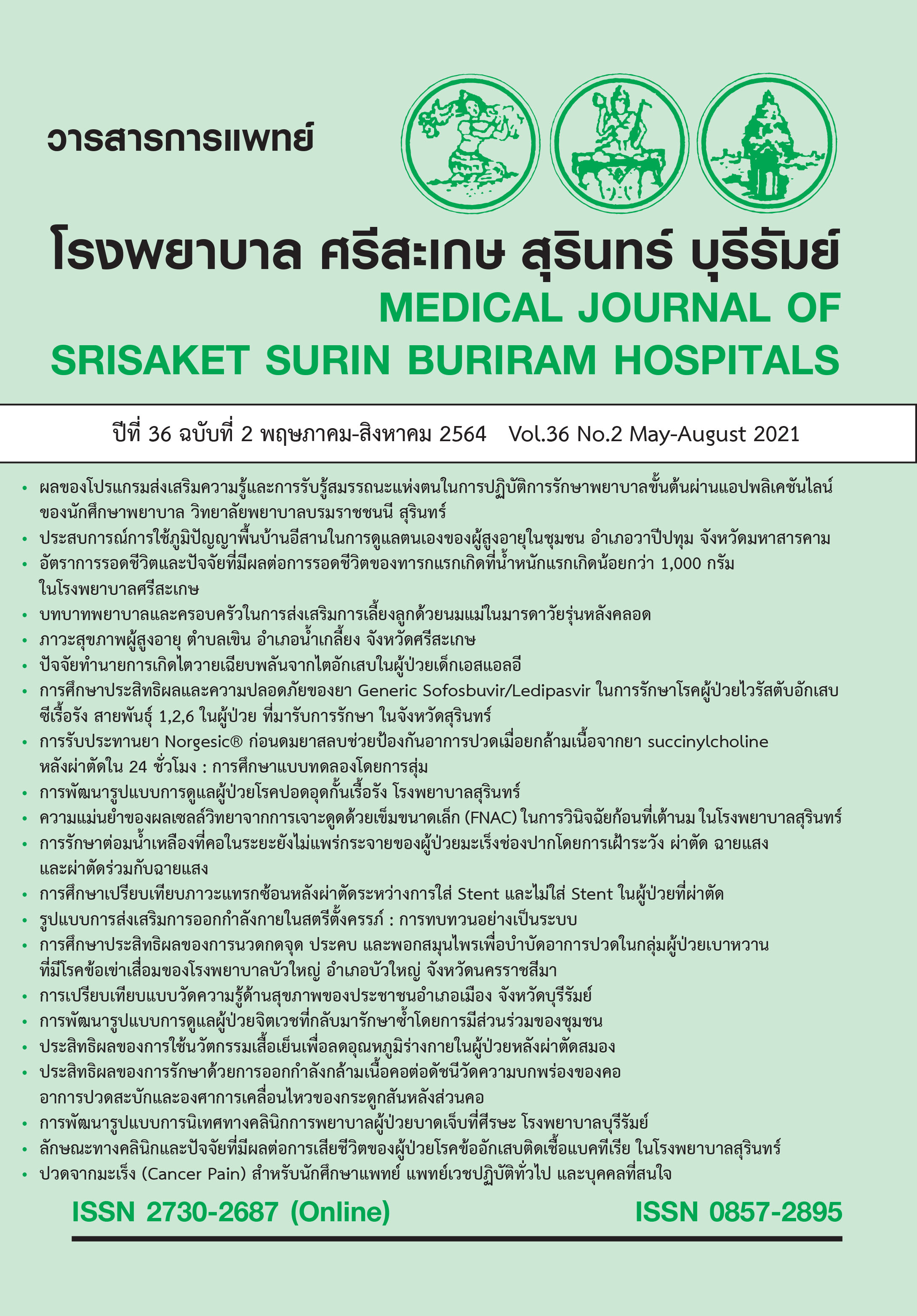ประสิทธิผลของการรักษาด้วยการออกกำลังกล้ามเนื้อคอต่อดัชนีวัดความบกพร่องของคอ อาการปวดสะบักและองศาการเคลื่อนไหวของกระดูกสันหลังส่วนคอในผู้ป่วยปวดคอร้าวลงสะบัก
Main Article Content
บทคัดย่อ
หลักการและเหตุผล: อาการปวดสะบักเป็นปัญหาที่พบบ่อยที่มีสาเหตุมาจากภาวะหมอนรองกระดูกสันหลังระดับคอปลิ้น หรือ herniated nucleus pulposus (HNP) ดังนั้นผู้ป่วยมักมาด้วยอาการปวด ตึง ชา ตำแหน่งคอบ่าและสะบักหรือที่คนทั่วไปเรียกว่าออฟฟิศซินโดรม (office syndrome) ทำให้เกิดความผิดปกติของการเคลื่อนไหว รบกวนการทำงานหรือทำกิจวัตรประจำวัน นำไปสู่ปัญหาเรื้อรัง ส่งผลต่อโครงสร้างของกระดูกและกล้ามเนื้อเปลี่ยนแปลงไป
วัตถุประสงค์: งานวิจัยเชิงทดลองนี้มีจุดประสงค์เพื่อศึกษาเปรียบเทียบดัชนีวัดความบกพร่องของคอ (neck disability index, NDI) ระดับอาการปวดสะบัก (numerical pain rating scale, NPRS) และ องศาการเคลื่อนไหวคอ (cervical range of motion, CROM) ก่อนและหลังการให้โปรแกรมการออกกำลังกล้ามเนื้อคอในผู้ป่วยปวดคอร้าวลงสะบัก
วิธีการศึกษา: อาสาสมัครเป็นผู้ป่วยมารับบริการที่แผนกกายภาพบำบัด โรงพยาบาลสุทธาเวช คณะแพทยศาสตร์ มหาวิทยาลัยมหาสารคาม วัดผลการทดลองในสัปดาห์ที่ 0 และ 8 จำนวนผู้เข้าร่วมวิจัย 22 ราย แบ่งเป็น 2 กลุ่ม คือ กลุ่มควบคุม (กลุ่มรักษาด้วยกายภาพบำบัดมาตรฐาน) จำนวน 11 ราย และกลุ่มทดลอง (กลุ่มรักษาด้วยกายภาพบำบัดมาตรฐานร่วมกับการออกกล้ามเนื้อคอ) จำนวน 11 รายเข้ารับการรักษาสัปดาห์ละ 1-2 ครั้ง
ผลการศึกษา: ผลการศึกษาพบว่าก่อนการทดลองค่า NDI ค่า NPRS และ ค่าองศาการเคลื่อนไหวคอในท่าก้มและท่าเงย (CROM in Flexion/Extension)ระหว่าง 2 กลุ่มไม่แตกต่างกัน แต่หลังการทดลอง ค่า NDI ลดลงอย่างมีนัยสำคัญทางสถิติทั้งในกลุ่มควบคุมและกลุ่มทดลอง และค่ามัธยฐาน (ค่าสูงสุด-ค่าต่ำสุด) ของ NDI ในกลุ่มทดลอง[4.0(0.0-18.0)]ลดลงมากกว่ากลุ่มควบคุม [15.0(4.0-28.0)]อย่างมีนัยสำคัญทางสถิติ(U=-2.869,p-value=0.003)ในทำนองเดียวกัน หลังการทดลอง ค่า NPRS ในกลุ่มทดลอง[10.0 (0.0-30.0)]ก็ลดลงมากกว่ากลุ่มควบคุม[50.0(20.0-70.0)]อย่างมีนัยสำคัญทางสถิติ(U=-3.776,p-value0.000)และเมื่อวิเคราะห์ CROM in Flexion หลังการทดลองไม่แตกต่างกันแต่ CROM in Flexion หลังการทดลองในกลุ่มควบคุมเพิ่มขึ้นอย่างมีนัยสำคัญทางสถิติเมื่อเปรียบเทียบกับก่อนทดลอง(z=2.196,p-value=0.028)ในทางตรงกันข้าม หลังการทดลอง CROM in Extension ของกลุ่มทดลองเพิ่มขึ้นอย่างมีนัยสำคัญทางสถิติเมื่อเปรียบเทียบกับก่อนทดลอง(z=2.667,p-value=0.008)
สรุป: โดยสรุปเมื่อได้รับโปรแกรมการออกกำลังกล้ามเนื้อคอร่วมด้วย ความรุนแรงและอาการปวดลดลงมากกว่าการรักษาด้วยกายภาพบำบัดมาตรฐานเพียงอย่างเดียว และยังสามารถช่วยคงค่าองศาการเคลื่อนไหวในทิศทางเงยหน้า ซึ่งเป็นทิศทางที่เหมาะสมสำหรับผู้ป่วยปวดสะบักที่มีปัญหามาจากภาวะหมอนรองกระดูกสันหลังระดับคอปลิ้น ผู้ป่วยกลุ่มนี้จึงควรได้รับคำแนะนำและการออกกำลังกายดังกล่าวอย่างต่อเนื่องเพื่อป้องกันการกลับมาเป็นซ้ำด้วยอาการเดิม
คำสำคัญ: หมอนรองกระดูกสันหลังส่วนคอปลิ้น, ดัชนีวัดความบกพร่องของคอ, ปวดสะบัก, การออกกำลังกาย, กายภาพบำบัด
Article Details
เอกสารอ้างอิง
Boyles R, Toy P, Mellon J, Jr., Hayes M, Hammer B. Effectiveness of manual physical therapy in the treatment of cervical radiculopathy: a systematic review. J Man Manip Ther. 2011;19(3):135-42. doi: 10.1179/2042618611Y.0000000011.
van Middelkoop M, Rubinstein SM, Ostelo R, van Tulder MW, Peul W, Koes BW, et al. Surgery versus conservative care for neck pain: a systematic review. Eur Spine J. 2013;22(1):87-95. doi: 10.1007/s00586-012-2553-z.
Dunning JR, Cleland JA, Waldrop MA, Arnot CF, Young IA, Turner M, et al. Upper cervical and upper thoracic thrust manipulation versus nonthrust mobilization in patients with mechanical neck pain: a multicenter randomized clinical trial. J Orthop Sports Phys Ther 2012;42(1):5-18. doi: 10.2519/jospt.2012.3894.
Griswold D, Learman K, O'Halloran B, Cleland J. A preliminary study comparing the use of cervical/upper thoracic mobilization and manipulation for individuals with mechanical neck pain. J Man Manip Ther 2015;23(2):75-83. doi: 10.1179/2042618614Y.0000000095.
Gross A, Kay TM, Paquin JP, Blanchette S, Lalonde P, Christie T, et al. Exercises for mechanical neck disorders. Cochrane Database Syst Rev 2015;1:CD004250. doi: 10.1002/14651858.CD004250.pub5.
Costello M. Treatment of a patient with cervical radiculopathy using thoracic spine thrust manipulation, soft tissue mobilization, and exercise. J Man Manip Ther 2008;16(3):129-35. doi: 10.1179/jmt.2008.16.3.129.
Chu ECP, Lo FS, Bhaumik A. Plausible impact of forward head posture on upper cervical spine stability. J Family Med Prim Care 2020;9(5):2517-20. doi: 10.4103/jfmpc.jfmpc_95_20.
Kang JI, Choi HH, Jeong DK, Choi H, Moon YJ, Park JS. Effect of scapular stabilization exercise on neck alignment and muscle activity in patients with forward head posture. J Phys Ther Sci 2018;30(6):804-8. doi: 10.1589/jpts.30.804.
En MC, Clair DA, Edmondston SJ. Validity of the Neck Disability Index and Neck Pain and Disability Scale for measuring disability associated with chronic, non-traumatic neck pain. Manual therapy 2009;14(4):433-8. doi: 10.1016/j.math.2008.07.005.
Luksanapruksa P, Wathana-apisit T, Wanasinthop S, Sanpakit S, Chavasiri C. Reliability and validity study of a Thai version of the Neck Disability Index in patients with neck pain. J Med Assoc Thai 2012;95(5):681-8. PMID: 22994028
MacDermid JC, Walton DM, Avery S, Blanchard A, Etruw E, McAlpine C, et al. Measurement properties of the neck disability index: a systematic review. J Orthop Sports Phys Ther 2009;39(5):400-17. doi: 10.2519/jospt.2009.2930.
Haefeli M, Elfering A. Pain assessment. Eur Spine J 2006;15 Suppl 1:S17-24. doi: 10.1007/s00586-005-1044-x.
Ma XL. A new pathological classification of lumbar disc protrusion and its clinical significance. Orthop Surg 2015;7(1):1-12. doi: 10.1111/os.12152.
Jellad A, Ben Salah Z, Boudokhane S, Migaou H, Bahri I, Rejeb N. The value of intermittent cervical traction in recent cervical radiculopathy. Ann Phys Rehabil Med 2009;52(9):638-52. doi: 10.1016/j.rehab.2009.07.035.
Cleland JA, Glynn P, Whitman JM, Eberhart SL, MacDonald C, Childs JD. Short-term effects of thrust versus nonthrust mobilization/manipulation directed at the thoracic spine in patients with neck pain: a randomized clinical trial. Physical therapy 2007;87(4):431-40. doi: 10.2522/ptj.20060217.
Kang JI, Choi HH, Jeong DK, Choi H, Moon YJ, Park JS. Effect of scapular stabilization exercise on neck alignment and muscle activity in patients with forward head posture. J Phys Ther Sci 2018;30(6):804-8. doi: 10.1589/jpts.30.804.
Mostamand J, Lotfi H, Safi N. Evaluating the head posture of dentists with no neck pain. J Bodyw Mov Ther 2013;17(4):430-3. doi: 10.1016/j.jbmt.2012.11.002.
Caneiro JP, O'Sullivan P, Burnett A, Barach A, O'Neil D, Tveit O, et al. The influence of different sitting postures on head/neck posture and muscle activity. Man Ther 2010;15(1):54-60. doi: 10.1016/j.math.2009.06.002.
Kim BB, Lee JH, Jeong HJ, Cynn HS. Effects of suboccipital release with craniocervical flexion exercise on craniocervical alignment and extrinsic cervical muscle activity in subjects with forward head posture. J Electromyogr Kinesiol 2016;30:31-7. doi: 10.1016/j.jelekin.2016.05.007.
Howell ER. The association between neck pain, the Neck Disability Index and cervical ranges of motion: a narrative review. J Can Chiropr Assoc 2011;55(3):211-21. PMID: 21886283
Meisingset I, Stensdotter AK, Woodhouse A, Vasseljen O. Neck motion, motor control, pain and disability: A longitudinal study of associations in neck pain patients in physiotherapy treatment. Man Ther 2016;22:94-100. doi: 10.1016/j.math.2015.10.013.
Rudolfsson T, Bjorklund M, Djupsjobacka M. Range of motion in the upper and lower cervical spine in people with chronic neck pain. Man Ther 2012;17(1):53-9. doi: 10.1016/j.math.2011.08.007.
Lee MH, Park SJ, Kim JS. Effects of neck exercise on high-school students' neck-shoulder posture. J Phys Ther Sci 2013;25(5):571-4. doi: 10.1589/jpts.25.571.
Ylinen J, Takala EP, Nykanen M, Hakkinen A, Malkia E, Pohjolainen T, et al. Active neck muscle training in the treatment of chronic neck pain in women: a randomized controlled trial. Jama 2003;289(19):2509-16. Jama 2003;289(19):2509-16.
Petersen S, Domino N, Postma C, Wells C, Cook C. Scapulothoracic Muscle Strength Changes Following a Single Session of Manual Therapy and an Exercise Programme in Subjects with Neck Pain. Musculoskeletal Care 2016;14(4):195-205. doi: 10.1002/msc.1132.


